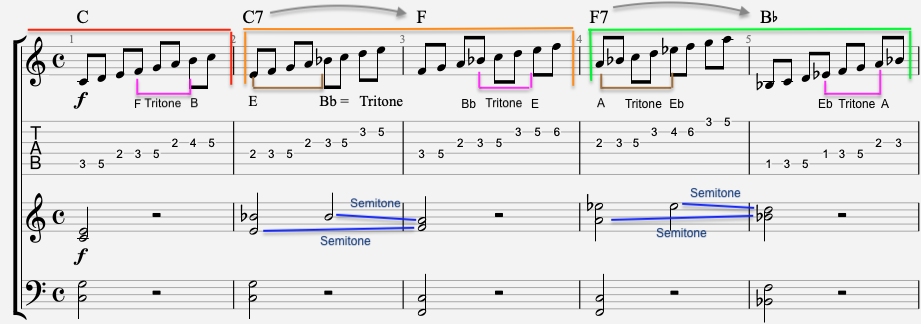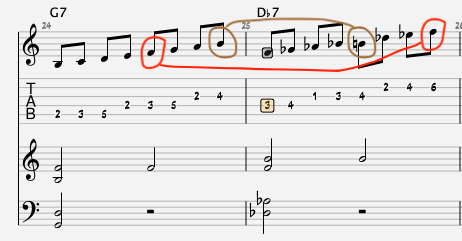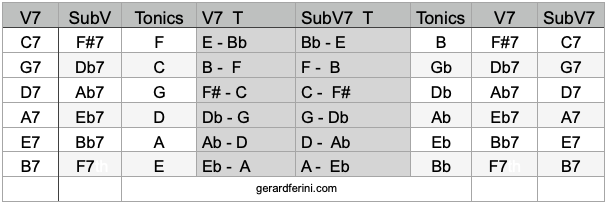Chords part III (Practise)
Practising with Dominant seventh Chords
It is time now, that one tries to understand the circle of fifths concept. We have seen before, that the function of the dominant chord is to "smoothly land" on the tonic chord by an opposite motion from its seventh and third degree going upwards and downwards to the tonic chord. (See Chord II). The example below evolves through the circle of Fifths down a 5th. We start with C major, then proceed to F thus covering all the Circle of Fifths chords. (See picture below).
Note that:
- C chord (I degree) is the starting Key. (in red)
- Next, we have C7 chord (dominant V7) that belongs to F Key and lasts two bars. (in orange)
- C7 resolves on F by two semitones motion. (E - B♭) Tritone.
- F becomes now the New tonic or key (I degree).
- Next, we have F7 chord (dominant V7) that belongs to Bb Key and lasts two bars. (in green)
- F7 resolves on B♭ by the two semitones. (A - E♭) Tritone.
- B♭becomes the New tonic or key (I degree).
- We can carry on until we reach C again.
- This technique is called, modulation to the dominant and uses neighbour chords.
- Full video below.
The Circle of Fifths scales practice will give an example of using a scale with its relevant chord, following the Circle of Fifths counterclockwise. Another point here to mention, is, tritone sharing. G7 and D♭7 share the same tritone. (See Tritone reference table below)
what is tritone substitution in music?
Another point here to mention is Tritone substitution. The tritone substitution can be performed by exchanging a dominant 7th chord for another dominant 7th chord placed in the opposite position. See below. G7 -- D flat7. See Circle of Fifths. It is then possible, to use chord substitution (SubV7) to improvise in G7 under a D flat7 chord.
Tritone Sharing example: in red, F note, in G7 and Db7 chords. In brown, B note in G7 and D♭7 chord.
The Dominant Seventh (V7) chords and The Substitute Dominant Chords (Sub V7) Table:
On the left row, we find, the dominant (V7) chords and on the right row, we have, the Subdominant chords (SubV7). See Tritone in the middle of the table. Notice, that C7 and F#7 share the same triton, however not in the same position or sense.
One easy way to find any Tritone: For instance, D7 that resolves on G.
- Take the major third of D7, namely F#.
- Take the minor seventh of D7, namely C
- So you have as a Tritone, F# and C




